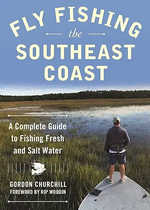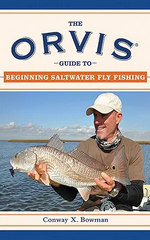Or... "Oh My Goodness, He's at it Again"
Just when you thought it was safe to open up your email again, here I am with another “essay” on fly fishing.
But the topic is important. Consider this. Some fly lines now cost over $100 a spool- for 90-110 feet of fly line. My goodness. The question is, what can I do to keep that fly line in good shape?
In previous “essays,” we have talked about rinsing you line, particularly after fishing in saltwater.t (If you think this is stupid, do it just one and then dry the line with a white towel -cloth or paper- and see all the junk that comes off in the towel. Convinced yet?) We have suggested keeping it out of direct sunlight as much as possible. We have mentioned using a non-detergent cleaner such as Woolite or a commercial line cleaner such as Loon’s Line Speed (expensive but cheaper than new line) to clean and help restore your line. All these are still excellent ways to prolong the life of your line.
But something important was mentioned so briefly that it is likely you missed seeing it. That important something is reeling the line back on you reel in an orderly fashion. Yep, reeling the line back on your reel.
Consider this. When you have hoses around your house, what happens to them if they are not rolled up smoothly and orderly, just pulled in and piled up? They get kinks in them. Then the kinks get set in the material so it is harder to roll them up the next time. The kinks become fairly permanent and cracks begin to develop at those kinks. Before you know it, you have a worthless hose. So, you go back to the store and buy another one and treat it the same way.
That’s what happens to your fly line when you reel it in without trying to make each coil lie down beside the previous coil. A loop of line gets caught under the pressure of other line reeled in on top of it. Disaster will result. You won’t be able to cast as well and if you do cast and happen to get a fish, the fish runs for it and you line breaks. Or you reel it in most of the line and it collects on one side of the reel to the point that it runs into the reel frame and you have to pull it out in order to reel in your big fish, which, by now, has gotten help from you in putting slack in the line, has thrown the hook and gone home to sulk and chuckle. Meanwhile, you are standing there like a “reel” dork. Horrors. You lose you fish and some of your expensive line- no, make that all of your expensive line.
Growing up, my brothers and I did a lot of fishing. We had baitcasting reels, our Dad had a wonderful spinning reel (yep, an old Mitchel) and one uncle had one of the old green Penn spinning reels on a surf rod (it still works, by the way). But the other uncle, who was the serious angler in the family, had a batch of big Penn trolling reels, many of which did not have level wind features. The reason then and the reason now that you never want a level wind reel if you are going after King Mackerel or any powerful fish that swims real fast is quite simple. Those fast runs are too fast and furious for a level wind to handle. In other words, they will destroy your reel in a heartbeat. The reel will quit singing and start smoking. This is not good.
So, many of this uncle’s rods didn’t have level wind. My brothers and I got in the habit of guiding the line back on the reel as we were reeling in using one or more of our fingers and/or a thumb as the level wind. We would guide the line so it went back on the reel smoothly. Otherwise, the line would pile up on one side or the other to the point it would bang into the frame of the rod, stopping the reel from working- again, broken line, a lost fish, a messed-up reel not to mention a scornful glare and word or two from our uncle who had a very low tolerance for stupidity, particularly when it dealt with engines, boats or fishing.
The trick is to use one of two fingers (each person will have to develop their own style) to guide the line back on so it goes on fairly level. That’s tough to do when you’re fighting a fish and diverting your attention. It’s tough to do if you haven’t been doing it for decades on big trolling or bottom rigs. It’s tough to do when you first get started and are trying to learn.
But don’t wait until you are reeling in a 25 lb. red or a 40 lb. whatever or a 100 lb. denizen of the deep. You can practice when you have cleaned the line and are putting it back on the reel. You can practice after you have been practice casting in your back yard or the local pond. (You are practicing, aren’t you?) Or you can get you reel, pull off all the fly line and practice putting it back on the reel evenly.
The technique must be natural for you- as natural as falling off a log.
So, practice it, unless you get your jollies losing fish from broken fly line or have an obsession paying big bucks for new line every few months. It makes a difference. Try it, you’ll like it.
I tend to use one or two fingers, depending. I’ll be glad to show you my method anytime. But develop your own and do it! Just do it! Do it automatically without having to think about it. You’ll be able to cast better, fight fish better and visit the tackle shop less frequently to buy new line.



